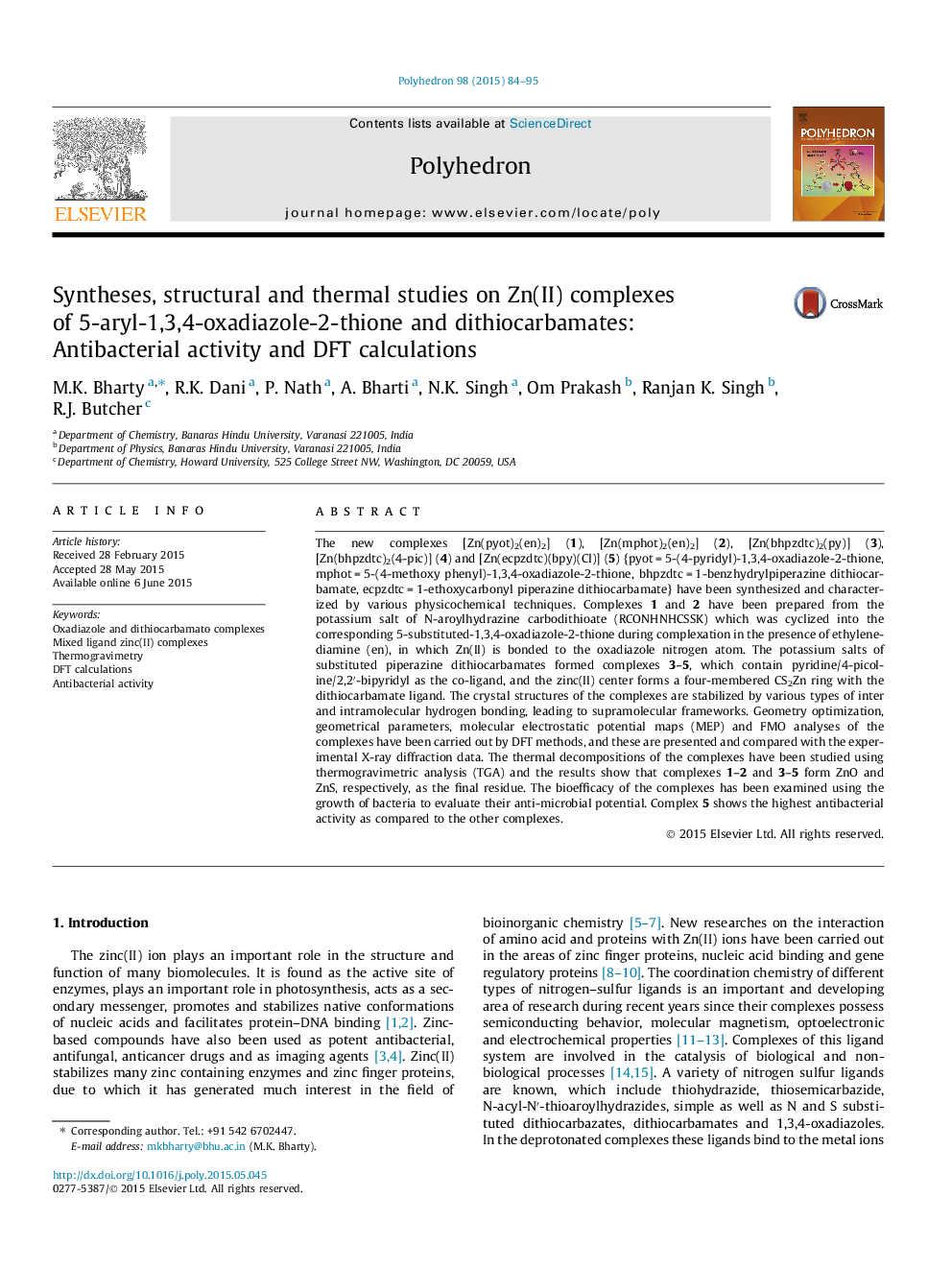| کد مقاله | کد نشریه | سال انتشار | مقاله انگلیسی | نسخه تمام متن |
|---|---|---|---|---|
| 1334346 | 1500241 | 2015 | 12 صفحه PDF | دانلود رایگان |

The new complexes [Zn(pyot)2(en)2] (1), [Zn(mphot)2(en)2] (2), [Zn(bhpzdtc)2(py)] (3), [Zn(bhpzdtc)2(4-pic)] (4) and [Zn(ecpzdtc)(bpy)(Cl)] (5) {pyot = 5-(4-pyridyl)-1,3,4-oxadiazole-2-thione, mphot = 5-(4-methoxy phenyl)-1,3,4-oxadiazole-2-thione, bhpzdtc = 1-benzhydrylpiperazine dithiocarbamate, ecpzdtc = 1-ethoxycarbonyl piperazine dithiocarbamate} have been synthesized and characterized by various physicochemical techniques. Complexes 1 and 2 have been prepared from the potassium salt of N-aroylhydrazine carbodithioate (RCONHNHCSSK) which was cyclized into the corresponding 5-substituted-1,3,4-oxadiazole-2-thione during complexation in the presence of ethylenediamine (en), in which Zn(II) is bonded to the oxadiazole nitrogen atom. The potassium salts of substituted piperazine dithiocarbamates formed complexes 3–5, which contain pyridine/4-picoline/2,2′-bipyridyl as the co-ligand, and the zinc(II) center forms a four-membered CS2Zn ring with the dithiocarbamate ligand. The crystal structures of the complexes are stabilized by various types of inter and intramolecular hydrogen bonding, leading to supramolecular frameworks. Geometry optimization, geometrical parameters, molecular electrostatic potential maps (MEP) and FMO analyses of the complexes have been carried out by DFT methods, and these are presented and compared with the experimental X-ray diffraction data. The thermal decompositions of the complexes have been studied using thermogravimetric analysis (TGA) and the results show that complexes 1–2 and 3–5 form ZnO and ZnS, respectively, as the final residue. The bioefficacy of the complexes has been examined using the growth of bacteria to evaluate their anti-microbial potential. Complex 5 shows the highest antibacterial activity as compared to the other complexes.
The new complexes [Zn(pyot)2(en)2] (1), [Zn(mphot)2(en)2] (2), [Zn(bhpzdtc)2(py)] (3), [Zn(bhpzdtc)2(4-pic)] (4) and [Zn(ecpzdtc)(bpy)(Cl)] (5) {pyot = 5-(4-pyridyl)-1,3,4-oxadiazole-2-thione, mphot = 5-(4-methoxy phenyl)-1,3,4-oxadiazole-2-thione, bhpzdtc = 1-benzhydrylpiperazine dithiocarbamate, ecpzdtc = 1-ethoxycarbonyl piperazine dithiocarbamate} have been synthesized and characterized by various physicochemical techniques. Complexes 1 and 2 have been prepared from the potassium salt of N-aroylhydrazine carbodithioate (RCONHNHCSSK) which is cyclized into the corresponding 5-substituted-1,3,4-oxadiazole-2-thione during complexation in the presence of ethylenediamine (en). The potassium salts of substituted piperazine dithiocarbamates formed complexes 3–5, which contain pyridine/4-picoline/2,2′-bipyridyl as the coligand, and the zinc(II) center forms a four-membered CS2Zn ring with the dithiocarbamate ligand. TGA indicates that the complexes 1,2 and 3–5 form ZnO and ZnS, respectively as the final residue. Complex 5 shows the highest antibacterial activity as compared to the other complexes. The X-ray crystallographic results of the complexes compare well with those obtained by the DFT method.Figure optionsDownload as PowerPoint slide
Journal: Polyhedron - Volume 98, 25 September 2015, Pages 84–95